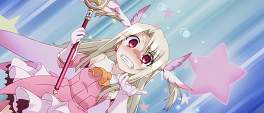Fate/kaleid liner Prisma Illya. Fate: okay, keeping with the Type-Moon Fate/* series naming scheme. Kaleid: kaleidoscope? Liner: hang on, what am I lining? Prisma: prism? plasma? Illya: of the von Einzberns, right.
I’d like to say that the individual words make sense on their own but “kaleid” and “prisma” only sound like they should be words; so all together the series title is just nonsense. It joins legions of other magical girl series (I’m looking at you here Nanoha) with silly titles though and may as well be called Fate/something or other: we got bored of the Holy Grail war. With all of the remakes and prequels and other Fate/* paraphernalia rolling around, turning the tragicly precocious child Illya von Einzbern into a magical girl certainly wasn’t the most obvious of routes to take.
It’s within Type-Moon’s remit though when you consider the very silly Carnival Phantasm OVAs, but as to whether Prisma Illya contains the same amount of in-jokes and sight gags - I’m not really the right person to ask. I’m also not the foremost expert on magical girl shows in general (despite early and prolonged exposure to Sailor Moon, Utena et. al.) so like with Sakura Trick, I can’t authoritatively proclaim its effect on its genre. Regardless, Illya’s transformation into a magical girl is at least unique and pleasantly expedited, with her partner in cosplay joining her within a few episodes.
The flimsy plot concerns Fate stalwart Rin Tohsaka and her series unique partner Luviagelita Edelfelt coming to Japan to hunt down magical cards in order to… Well to do something that likely won’t ever be explained. It’s certainly odd to see Rin with cat-ears and a tail flying gaily about the sky trading quips and blows with her busty, curly haired comrade. Why new initiates Illya and Miyu don’t have animal features when the Navi-esque magical rods mutiny and chose new masters is probably related to the inordinate number of bath scenes or the more-than-implied sapphic overtones to Illya and Miyu’s relationship. It’s fair to say that this is tonally very different to all of the other Fate entries and has a sense of fun and abandon that other more straight-laced Type-Moon endeavours don’t have.
It certainly has the looks though. Coming from the same studio that animated Baka Test, Illya is beautifully presented with lustrous soft shading for all the characters and magical skirmishes that crank the iridescent styling of Fate/zero all the way to eleven. Even the floating rods Ruby and Sapphire, devoid of any emotive features, are afforded a surprising amount of personality by squashing and bending when talking or being manhandled by Rin. It’s not enough to make you ignore the very well trodden magical girl themes though; even in the wake of Madoka (though the source manga does precede that series by a number of years) the old standbys of friendship, teamwork and questioning why you fight are front and centre.
Even Illya herself is the same kind of clumsy, heart-on-her-sleeve archetype that many genre protagonists seem to fall into. Miyu is granted a little more character though her background of destitution and loneliness is never elaborated upon and we end the series with little more information about her than we started. With only ten episodes it’s not entirely unexpected though this is something that the announced second series, the cringe inducingly subtitled “2wei”, may address. For the most part though this series busies itself with battles that, despite their length, don’t overstay their welcome even when one stretches on for almost a third of its runtime. This leaves the school sections with Illya’s gallery of pint-sized friends the worst parts of the series with stagnant humour and a general lack of exuberance typified elsewhere, even in the frankly baffling maid side story.
Fundamentally there aren’t enough original ideas in Fate/kaleid liner Prisma Suplex Eidetikos Heartbeam Illya to recommend it either as a Type-Moon franchise entry or as a magical girl series. Even its inclusion in the Fate universe, alternate or no, seems to add little more than some recognisable noble phantasms and some pleasant subversions of characters that you may or may not be familiar with. The story follows a predictable arc with few surprises beyond Mummy Einzbern showing up and laying down some magical girl best practice leaving only the battles and the sterling accompanying visuals to make up. This is after all the type of magical pugilism that favours tinsel over tactics, and if you can overlook the multitude of worrisome bath scenes there is a lot of fun to be had. It certainly doesn’t do justice to its genre contemporaries or its heritage but then it would take an awful lot to accomplish either.











The anime, for some bizarre reason, wrote out most hints at a darker explanation for Illya and Miyu. Illya is STILL an artificial Homunuculi, successfully induced to live a normal live - and her parents prefer it to be kept that way. This Illya is every bit as potentially powerful, as Fate Stay Night's Illya, with it's implied costs. It's just that this Illya has been given a happier life, among all the Multi-universal possible worlds in the Fate/ Nasuverse.
The Kaleidoscopes are devices that transcend dimensions, with interesting implications that become apparent in the third manga. But the second season should give you more answers, especially in the connection between Fate Illya and the broader Fate Series.